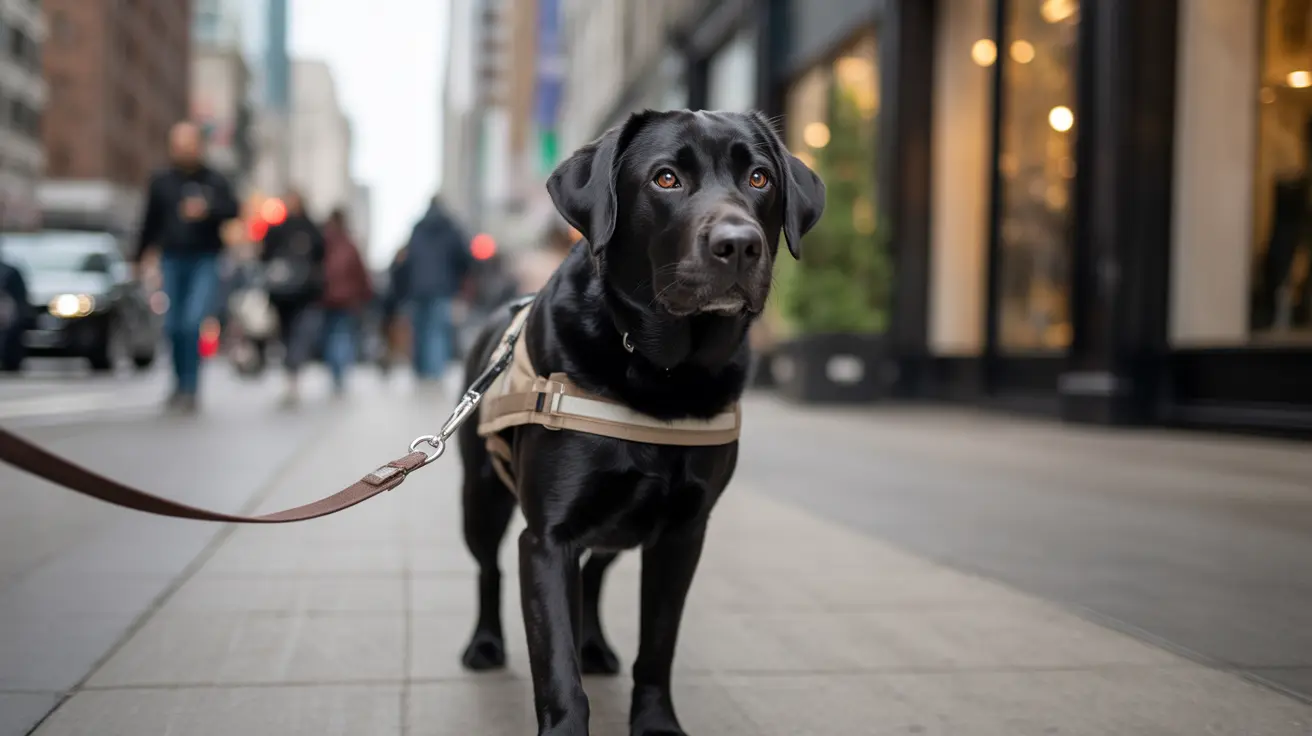Guide Dog Etiquette and Common Mistakes to Avoid: Essential Guidelines for Respectful Interactions
When you encounter a person with a guide dog, your actions can significantly impact their safety and independence. Unfortunately, many well-meaning individuals make common mistakes that can distract these highly trained working animals and potentially create dangerous situations. Understanding proper guide dog etiquette isn't just about being polite—it's about respecting the vital partnership between a person who is blind or visually impaired and their canine companion.
Guide dogs serve as the guiding eyes for people who are blind or visually impaired, undergoing extensive training that lasts 2-3 months before being paired with their handler for joint training. These specially bred dogs, typically Labradors, Golden Retrievers, and German Shepherds, are responsible for navigating a space roughly twice as wide and three times as tall as themselves. By learning the do's and don'ts of guide dog interactions, you can help ensure these remarkable teams can move through the world safely and confidently.
Understanding the Working Relationship Between Guide Dogs and Their Handlers
The partnership between a guide dog and their handler represents one of the most sophisticated forms of assistance animal relationships. These dogs are not pets—they are highly trained professionals performing life-saving work that requires complete focus and concentration. When a guide dog is wearing its white harness or vest, it signals that the animal is actively working and should not be distracted in any way.
Guide dogs are responsible for obstacle detection, intelligent disobedience when commands would lead to danger, and maintaining their handler's safety while navigating complex environments. This working relationship takes time to develop, and newly graduated guide dog teams require patience as they build harmony and confidence together. The dog's ability to concentrate on these critical tasks can be compromised by even seemingly harmless interactions from the public.
Critical Mistakes to Avoid When Encountering Guide Dog Teams
Never Distract a Working Guide Dog
The most common and dangerous mistake people make is interacting with a guide dog while it's working. When you see a dog wearing a harness, resist the urge to pet, talk to, feed, or otherwise distract the animal. Even calling the dog's name or making eye contact can break its concentration and create a potentially hazardous situation for the handler.
Children should be taught early about the difference between pets and service dogs. A distracted guide dog might miss important obstacles, traffic dangers, or navigation cues that could put their handler at risk. Remember that a sleeping service dog is still on duty, so avoid interaction even when the animal appears to be resting.
Don't Touch or Control the Harness
Never grab, steer, or attempt to hold a guide dog's harness. The harness represents the direct communication line between the dog and handler, and any interference can confuse both parties and disrupt their navigation. If you want to offer assistance, always speak directly to the handler first—never attempt to take control of the situation by grabbing the dog's equipment.
Similarly, avoid pulling, steering, or grabbing the person while their dog is guiding. If assistance is needed and requested, offer your left arm and allow the person to hold onto you, rather than trying to guide them yourself.
Keep Your Pets Away from Working Guide Dogs
Pet dogs can pose a significant distraction to working guide dogs. Keep your dog leashed and at a respectful distance when encountering a guide dog team. Even friendly interactions between dogs can break a guide dog's concentration and potentially lead to dangerous situations. If you want your pet to meet a guide dog, supervised meetings should only occur on neutral ground and with explicit permission from the handler.
Proper Etiquette When Offering Assistance
Always Address the Handler First
When you encounter a guide dog team, speak directly to the person, not to their dog or to any companions they might have. Use a normal tone of voice and identify yourself when starting a conversation. People who are blind often have acute hearing, so there's no need to shout or speak louder than normal.
If you believe someone might need assistance, ask politely rather than assuming. Many people with guide dogs are completely capable of navigating independently, and unwanted help can actually be more hindrance than assistance. Respect their response if they decline your offer—they may be having a challenging day, be in a hurry, or simply prefer to handle the situation independently.
Provide Specific, Clear Directions
When giving directions or information to someone with a guide dog, be specific rather than vague. Instead of saying "over there," provide clear directional information like "to your left about ten feet" or "straight ahead past the second doorway." It's perfectly acceptable to use words like "look," "see," or "watching TV" in normal conversation—these are common expressions that don't cause offense.
In restaurants, offer to read menus and receipts aloud, and describe the location of items on the table or around the dining area. Provide verbal cues about environmental changes such as stairs, curbs, or obstacles, but avoid calling out directions while the team is moving unless there's immediate danger.
Understanding Guide Dog Access Rights and Legal Protections
Under the Americans with Disabilities Act (ADA), people with disabilities have the legal right to be accompanied by their guide or service dogs in all public places. This includes locations that typically prohibit pets, such as supermarkets, medical offices, restaurants, and public transportation. These access rights are fundamental to ensuring independence and mobility for people who rely on guide dogs.
Guide and service dog teams have the right of way in public spaces, and businesses cannot charge additional fees or deposits for accommodating these working animals. When you witness unjust refusals of entry for guide dog teams, informing others about these legal protections can help support the rights of people who are blind or visually impaired.
If you work in the service industry, understanding these access rights is crucial for providing appropriate customer service and avoiding discrimination. Staff training on disability awareness and guide dog accommodation can significantly improve the experience for customers who rely on these working animals.
Recognizing Different Types of Working Service Dogs
While guide dogs specifically assist people who are blind or visually impaired, it's important to recognize that service dogs assist people with various disabilities including mobility limitations, epilepsy, PTSD, and other conditions. Each type of service dog performs specific tasks related to their handler's disability, and the same etiquette rules apply regardless of the type of assistance being provided.
Service dogs undergo extensive training and are generally mild-mannered, but you should never judge a service dog's capabilities based on prior experiences with other animals. These dogs are working professionals, and treating them as such shows respect for both the animal and the person they assist.
Special Situations and Environmental Considerations
Traffic and Navigation Assistance
Guide dogs cannot interpret traffic signals or determine when it's safe to cross streets based on traffic light colors. They rely on their handler's judgment and the sounds of traffic patterns. If you notice a guide dog team waiting at a crosswalk, it's appropriate to inform the handler when the pedestrian signal indicates it's safe to cross, but avoid honking car horns as signals, as this can be confusing and startling.
Proper Walking Etiquette
When walking with a guide dog team, position yourself on the handler's right side, a few paces behind, to avoid interfering with the dog's work space. The dog typically works on the handler's left side, so staying to the right prevents accidentally blocking the dog's movement or distracting it from its duties.
Maintain a safe distance and avoid sudden movements that might startle or distract the working dog. Ask the handler where they prefer you to walk if you're unsure about the best positioning.
Home Visits and Social Situations
When a person with a guide dog visits your home, there are specific considerations to ensure the comfort and safety of both the dog and handler. Never give the dog table scraps, as maintaining the animal's balanced diet and good eating habits is crucial for their health and training. Don't allow anyone to tease or abuse the dog, and ensure the animal can rest undisturbed when not actively working.
Guide dogs should not jump on furniture or enter certain areas of your home without agreement from both the family and the handler. Most importantly, never let the dog out of the house unsupervised—keep doors and gates securely closed to prevent the animal from escaping, as a lost guide dog represents not just a missing pet, but a person's independence and safety.
When a Guide Dog Approaches You Without Their Handler
In rare emergency situations, you might encounter a guide dog approaching you without their handler present. If this happens, the dog may be seeking help for their handler who could be in distress. Don't ignore this behavior—follow the dog to locate their handler, as this could be a life-threatening situation requiring immediate assistance.
This scenario demonstrates the intelligence and training of these remarkable animals, who are taught to seek help when their handler is unable to do so themselves.
Building Community Awareness and Support
September is National Guide Dog Month, providing an excellent opportunity to raise awareness and appreciation for guide dogs and their handlers within your community. Sharing knowledge about proper guide dog etiquette helps create a more inclusive and supportive environment for people who rely on these working animals.
Public places can better accommodate guide dog teams through comprehensive staff training and awareness campaigns that educate employees about legal requirements, proper interaction protocols, and the important work these dogs perform. This training helps prevent discrimination and ensures that people with guide dogs receive the same level of service and respect as all customers.
Frequently Asked Questions
Can I pet a guide dog if I ask permission first?
You should only ask to pet a guide dog when the animal is not wearing its harness or vest, indicating it's not currently working. Even then, if permission is granted, pet the dog gently on the shoulder area rather than the head. However, if the handler declines your request, don't be offended—the dog or handler may be having a challenging day or need to maintain the dog's focus for upcoming work.
What should I do if I see someone being denied entry because of their guide dog?
If you witness discrimination against a guide dog team, you can politely inform the business owner or staff about the legal rights of people with disabilities under the ADA. Guide dogs have legal access to all public places, and businesses cannot refuse service or charge additional fees for accommodating these working animals.
How long do guide dogs typically work before retiring?
Guide dogs typically retire between 8 and 10 years old, depending on their health and ability to perform their duties safely. After retirement, these dogs often become beloved family pets, either staying with their handler's family or being adopted by volunteers who helped with their training.
Is it okay to give directions to someone with a guide dog about traffic or obstacles?
It's appropriate to inform a guide dog handler when a pedestrian signal turns green, as guide dogs cannot interpret traffic lights. However, avoid calling out directions while the team is moving unless there's immediate danger. If you notice a significant hazard, politely get the handler's attention first before providing specific information about the obstacle.
What's the difference between a guide dog and other service dogs?
Guide dogs specifically assist people who are blind or visually impaired with navigation and obstacle avoidance. Other service dogs assist people with different disabilities, such as mobility limitations, seizure detection, or PTSD support. All service dogs receive specialized training for their specific tasks, and the same respectful interaction guidelines apply to all working service animals.
Can guide dogs go everywhere their handler goes?
Under the ADA, guide dogs have legal access to all public accommodations where their handlers are allowed, including restaurants, stores, airplanes, and public transportation. This access is protected by law, and businesses cannot restrict or charge extra fees for guide dog access.
What should I do if my pet shows aggression toward a guide dog?
Keep your pet leashed and under control at all times around guide dog teams. If your dog shows signs of aggression or excessive interest in a working guide dog, immediately create distance and remove your pet from the situation. Report any attacks on guide dog teams to both animal control and police, as interfering with a working service animal is a serious legal matter.
Conclusion
Understanding proper guide dog etiquette and avoiding common mistakes is essential for creating a safer, more inclusive community for people who rely on these remarkable working animals. By remembering that a harnessed guide dog is always working and should never be distracted, addressing the handler rather than the dog, and respecting the legal access rights of guide dog teams, you contribute to the independence and safety of people who are blind or visually impaired.
The partnership between a guide dog and their handler represents years of specialized training and mutual trust that enables navigation through complex environments. Your respectful behavior and awareness of proper etiquette helps protect this vital relationship while supporting the fundamental rights and dignity of people with disabilities. Remember that these guidelines aren't just about politeness—they're about recognizing and respecting the professional work these dogs perform and the independence they provide to their handlers every day.






